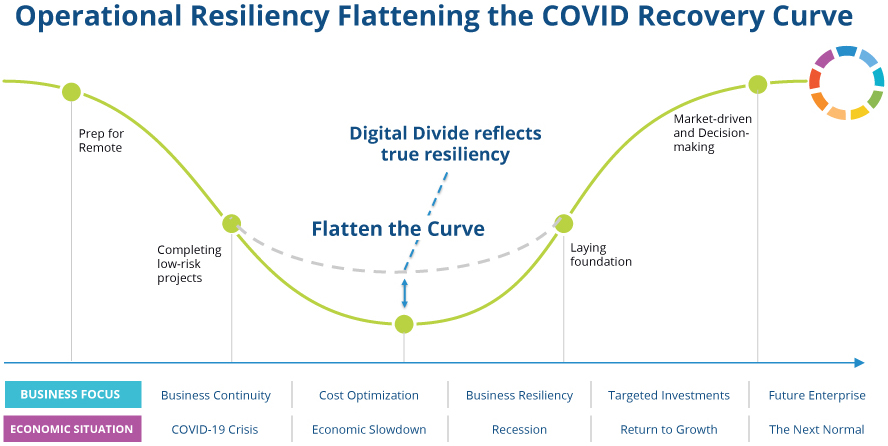The digital transformation journey for utilities will absolutely continue; however, COVID-19 has brought to light priorities that the industry can focus on in this "new normal" working environment. The COVID situation has utilities reexamining technology investments in key areas where the sector has an opportunity to strengthen its digital posture. Specifically, the COVID pandemic has brought heightened awareness to the importance of physical and industrial automation, enterprise automation such as robotic process automation (RPA), along with edge and cloud computing. These are all technology investments that can improve efficiencies, safety measures as well as save costs in these current economic times and in the long run.
Near-term
In the near-term utilities have focused on identifying the needs of essential employees who must report to work, as well as determining what the technology requirements are for functions that can be done remotely. There has been increased attention on operations personnel such as plant operators, control room staff and line workers who need to physically be at work to operate a power plant, run the control room or perform asset maintenance safely and efficiently. Utilities have always had high expectations and stringent regulations around employee safety, and this is now being amplified due to the outbreak of the coronavirus. To limit the amount of personnel needed in the field, the use of advanced mobile workforce management (MWFM) applications will most likely be increased. The use of technologies such as Augmented Reality and Virtual Reality (AR/VR) can help workers in the field gain access to critical information and effectively communicate and collaborate with other operational professionals who are working remotely. MWFM can also arm workers with critical operational data and analytics that detect anomalies in the performance of a utility's assets, enable access to maintenance records and evaluate preventative maintenance analysis all while in the field.
In addition to the operational side of the house, utilities have had to immediately address IT support and, in particular, the implementation of stronger cybersecurity measures for certain roles that can be done remotely. Utilities are increasing cybersecurity due to the sensitivity and privacy laws that go along with much of the data being used in roles for personnel who can work remotely in areas such as trading, human resources, accounting, customer service, legal and finance. Many of these functions already have heightened security measures when on-premise and would need similar or even enhanced security measures if working from home remotely using VPN on personal home networks.
Long-term
In the long-term, the COVID-19 virus will give a boost to automation and other technologies and applications such as machine learning and artificial intelligence, Utility operations will be a core area where technology can reduce significant costs and also provide the potential for higher revenues. A strategic approach to asset performance management will include increased automation which can improve maintenance and operations and in turn will reduce asset downtime and improve overall asset efficiency and output. Investments in increased automation, cloud, edge computing and analytics will be on the rise for the long-term with a greater emphasis being put on operational excellence for improving the bottom line for utilities. Tight profit margins and low energy commodity prices are expected for the foreseeable future which will put utilities under pressure to operate their assets in the most efficient manner possible.
COVID-19 will also bring to light the opportunity for better integration and stronger protocols around both cyber and physical security. The COVID-19 situation has organizations re-thinking their crisis management strategy and worst-case scenarios. Looking at the utility industry from this new lens and working environment will emphasize power system resilience in efforts that will ultimately improve operations. Although COVID-19 is not directly impacting asset performance, it has helped identify what functions are essential in utilities with operations being at the top of the list. Cyber and physical security has been a growing concern and an investment area for utilities as of late, but the crisis management approach that many organizations are working through at the moment will spill over into long-term efforts to protect and run assets at their most efficient levels. Utility assets are considered to be critical infrastructure, with the understanding that utilities, (e.g., electric, gas and water) are basic human necessities that cannot and should not be compromised.
Another technology that will get a long-term boost is cloud computing. COVID-19 has forced utilities to allow certain employees to work from home remotely. The cloud is key for remote collaboration and the ability to share data between workers that are dispersed. For large utilities in the U.S., in particular, the investor-owned utilities (IOUs) have been slow to adopt or invest in the cloud. This current situation which is creating unique circumstances for many workers gives could give cloud investments a boost. The acceptance of the cloud or lack of it by the IOUs utilities has in many cases been driven by how utilities will ultimately be able to pay for cloud technology and services. Utilities have been able to roll costs into a customer rate base for traditional capital investments such as power plants, transmission lines, substations, transformers, etc. If state public utility commissions can see the need and advantage of the cloud for both the short-term and the long-term, there may be the potential and an appetite to loosen regulations to allow the cloud to have cost recovery mechanisms comparable to capital asset investments for utilities. There has been some movement towards investing in the cloud in the utility space, although mostly, it has been painfully slow. The COVID-19 outbreak may give state regulators a new and appreciated perspective on the benefits that cloud technology can bring to utilities.
Operational resiliency flattening the COVID recovery curve
Resiliency and asset management have always been high priorities for utilities. Traditionally, grid resiliency for utilities has emphasized having the best measures in place to deal with unplanned outages and restoring power as quickly as possible. However, grid resiliency, especially how it relates to the COVID-19 pandemic has put more attention on how to manage and operate the power grid in a manner that can prevent outages and maintain system reliability. Similarly, the COVID-19 situation is shining a light on advanced technologies and processes that can improve the operations and management of power generating assets by applying a strategic approach to asset management to minimize downtime and optimize the output and efficiency of a utility's assets.
Utilities will stress the importance of grid resiliency and asset management as they go through the challenges of the current COVID-19 pandemic. When evaluating the current grid resiliency and asset management processes and procedures in place, utilities will look to identify areas where there can be improvements from a cost, time, reliability, and employee safety perspective. The COVID-19 pandemic will most likely result in utilities taking a more aggressive posture towards digital advancements in particular around operational excellence which includes protecting their assets and employees. Grid resiliency and asset management are expected to be high priorities for utilities as they consider both short- and long term-technology investments. Utilities with a focus on operational resiliency are expected to have a more stable transition and a stronger recovery coming out of the COVID situation. (See COVID Recovery Curve graphic).
Grid resiliency in the wake of COVID-19
Pre-COVID-19, grid resiliency primarily focused on the preparedness and response to natural disasters such as hurricanes, storms and tornadoes. The COVID-19 pandemic now has utilities looking at grid resiliency more comprehensively. Traditionally, grid resiliency has prioritized the handling of natural disasters with a large focus on "hardening" the grid to retain power along with an effective plan for outage management and the safe and timely restoration of energy. The approach to grid resiliency that is needed now by utilities during this COVID-19 situation has put preventative maintenance and power system reliability front and center. The use of technologies that can enable remote monitoring, edge computing, machine learning and access vast amounts of data and analytics can be used to ensure that the power system remains intact and power delivery is not disrupted, particularly for critical infrastructure and buildings such as hospitals, medical labs and other military and government facilities in the time of this crisis. These technologies will allow for a resilient grid and can also minimize the number of utility trucks and technicians that are needed out in the field.
In a time when power delivery and quality of service are crucial, utilities are identifying essential and vulnerable facilities to minimize the risk of poor power quality or outages. Utilities are ensuring that the power grid is reliable, in addition to monitoring and controlling backup generation to assure the delivery of electricity to these essential facilities 24/7. The ability to maintain power for critical infrastructure during this pandemic has been noticeably heightened. Additionally, this current utility environment has brought attention to the overall need for greater grid resiliency for the long-term which is likely to lead to further investments in microgrids and distributed generation which will improve power system reliability and sustainability during this COVID-19 pandemic and beyond.
A strategic approach to asset management
It is expected that lessons learned by utilities from the COVID-19 crisis will improve the approach to asset management in both the short-term and in the long-run. Asset management has historically been an exercise of scheduled maintenance, and in some cases, poorly efficient break/fix approaches. Strategic asset management, which is ideal for the current COVID-19 challenge, is an approach of predictive, preventative and prescriptive maintenance in efforts to best optimize a utility's assets. The ability to collect near real-time critical operational data remotely through the use of sensors, edge technologies and cloud computing will change asset management from a practice of scheduled maintenance to one that applies condition-based maintenance. Condition-based maintenance can leverage data, analytics, machine learning and artificial intelligence to identify potential or early-stage operational issues to prevent and get in front of asset failures before they occur, which will limit unplanned downtime, power interruptions or outages. Similar to grid resiliency, one of the main goals during the COVID-19 pandemic is to prevent unplanned outages on any asset.
Additionally, a large part of successful asset management is the use of advanced mobile workforce management or field services applications. Mobility can enable access to critical operational data while working in the field, which can save time and costs while improving the safety and efficiency of maintenance crews and technicians. Because of COVID-19, up and coming technologies like AR and VR will most likely get a boost in investments, as these technologies can help limit the number of personnel and the time required to be in the field. Mobility and technologies also will allow remote workers to assist, collaborate and guide personnel in the field when they are working on assets. The use of cloud and analytics can allow field workers access to operational data remotely, which will provide efficiency, save on labor costs as well as improve the safety for technicians in the field. Additionally, advanced mobile workforce management applications can modernize work orders, planning and scheduling, which will improve the overall process execution around asset management.
Considerations for utilities amid the COVID pandemic
As the coronavirus outbreak continues, the utility sector will need to be agile and move quickly to adapt not only to the bearish market conditions and declining shifts in electric demand but also it will need to contemplate changes in how to run their businesses and operations daily/ The following are some considerations for utilities during this pandemic and actions to evaluate for both the short-term and the long-term.
- Invest in automation. Automation investments will be key particularly on the operation side of the house and should be taken into consideration. The efficient operations of assets such as power plants and substations will reduce costs significantly in the long run and ensure limited downtime and maximum performance of a utility's assets.
- Take a strategic approach to grid resiliency. Invest in technologies and applications that can enable predictive, preventative, and prescriptive maintenance. In the immediate and near term be hypervigilant about minimizing power outages and disruptions for critical infrastructure such as hospitals, medical labs and government and military facilities.
- Enhance mobile workforce management capabilities. Technologies that enable access to near real-time critical operational data in addition to utilizing AR and VR can improve safety and efficiency while lowering the cost of maintenance being performed in the field.
- Investment in grid resiliency and asset management will help utilities and independent power producers effectively operate the power grid and generating assets in the middle of this COVID-19 situation. Operational excellence will emerge as a top priority in this current working environment. It will also remain a goal that organizations in the power sector strive for in the long-term, beyond the COVID-19 pandemic.
This article was adapted from the following IDC Perspective reports:
- Enhancing Grid Resiliency and Asset Management in the New COVID-19 Working Environment
- Coronavirus Impacts on the Energy Sector
 John Villali is a research director for IDC Energy Insights, primarily responsible for thought leadership in the areas of digital transformation and smart operations in the energy and utility sector. Villali's research helps utility and energy IT and business management understand the disruptions that are transforming the energy and utility value chains and develop the strategies and programs to capitalize on the evolving opportunities.
John Villali is a research director for IDC Energy Insights, primarily responsible for thought leadership in the areas of digital transformation and smart operations in the energy and utility sector. Villali's research helps utility and energy IT and business management understand the disruptions that are transforming the energy and utility value chains and develop the strategies and programs to capitalize on the evolving opportunities.








